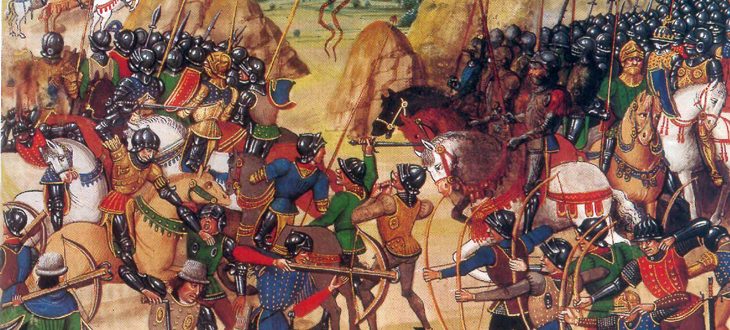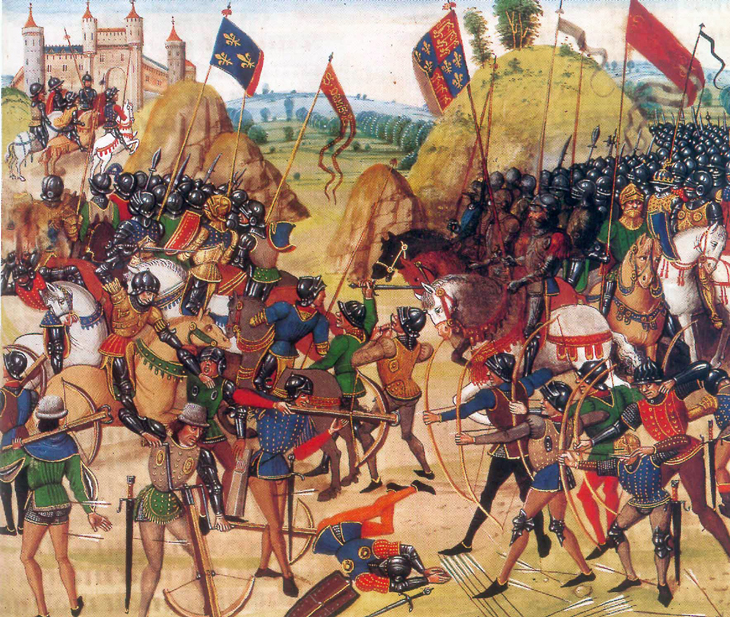What was the Hundred Years’ War?
By Dan Spencer
This is the traditional description given to a period of conflict between England and France during the years 1337 to 1453.
Starting with the attempted confiscation of the English-held Duchy of Gascony in 1337 and ending with the final expulsion of the English from Gascony in 1453.
Yet the name is misleading as it was not one continuous war and it covers a 116 year period!
This was a term invented by French historians in the early nineteenth century. Furthermore the origins of the conflict stretched back to the twelfth century as a result of the acquisition of the Duchy of Aquitaine by King Henry II of England, due to his marriage to Eleanor of Aquitaine. Hostilities also continued into the sixteenth century as a result of English attempts to reconquer their lost French lands.
Other countries also became involved in the struggle between England and France. This included Scotland which had been in conflict with England since the thirteenth century, and which was drawn into the conflict as a result of the ‘Auld Alliance’ which had been signed with France at the Treaty of Paris in 1295. The conflict also spread to the Iberian Peninsula in the fourteenth century, with the Kingdom of Castile allied to the French and the Kingdom of Portugal allied to the English. This was therefore a long running series of conflicts which at times incorporated large parts of Northern Europe.
A timeline of key events of the Hundred Years’ War
1337 – Philip VI of France orders the confiscation of the Duchy of Gascony from Edward III of England and sends an army to invade the duchy
1346 – Edward III defeats the French at the Battle of Crécy and then besieges Calais
1347 – Calais surrenders after a long siege
1356 – Edward Prince of Wales, more commonly known as the ‘Black Prince’, defeats a French army at the Battle of Poitiers and captures the French king, John II
1360 – Peace is agreed between England and France as part of the Treaty of Brétigny, with John II released in return for a large ransom and an enlarged Duchy of Aquitaine
1369 – War is resumed between England and France
1377 – Edward III dies and is succeeded by his grandson Richard II, with most of Aquitaine having been reconquered by the French
1389 – The Truce of Leulinghem is agreed between England and France
1399 – Richard II is deposed by his cousin Henry IV
1412 – Henry IV sends an army to France in support of the Armagnac faction
1413 – Henry V succeeds to the throne
1415 – Henry V invades France, captures the town of Harfleur and wins the Battle of Agincourt
1417-1419 – Henry invades France for a second time and conquers the Duchy of Normandy
1420 – An alliance is agreed between Philip the Good, Duke of Burgundy, and Henry V
1421 – Henry V is recognised as heir to Charles VI of France by the Treaty of Troyes
1422 – Henry V dies and is succeeded by his son Henry VI
1428 – An English army under the Earl of Salisbury begins the siege of Orléans
1429 – Joan of Arc lifts the siege of Orléans with the English later defeated at the Battle of Patay
1436 – The English successfully defend Calais from an attack by the Duke of Burgundy
1450 – The Duchy of Normandy is recaptured by the French, with the English defeated at the Battle of Formigny
1453 – An English army led by John Talbot, Earl of Shrewsbury, is defeated at the Battle of Castillon with Gascony lost for a second and final time
Later attempts were made to reconquer the lost French lands with armies taken to France by Edward IV (1475), Henry VII (1492) and Henry VIII (1513). Finally the Pale of Calais, England’s final remaining continental territory, was captured by the French in 1558.
This information came from Anne Curry, The Hundred Years War (Basingstoke: Palgrave Macmillan, 2003)
Image of the Battle of Crécy from Wikipedia and is in the Public Domain

